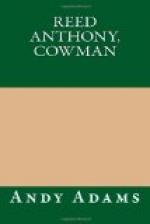On my reaching the ranch the first contingent of gathered cattle were under herd. They were a rag-tag lot, many of them big steers, while much of the younger stuff was clear of earmark or brand until after their arrival at the home corrals. The ranch help herded them by day and penned them at night, but on the arrival of the independent outfit with another contingent of fifteen hundred the first were freed and the second put under herd. Counting both bunches, the strays numbered nearly a thousand head, and cattle bearing no tally-mark fully as many more, while the remainder were mavericks and would have paid the expenses of the outfit for the past four months. I now had over thirty thousand cattle on the Clear Fork, holding them in eleven brands, but decided thereafter to run all the increase in the original “44.” This rule had gone into effect the fall previous, and I now proposed to run it on all calves branded. Never before had I felt the necessity of increasing my holdings in land, but with the number of cattle on hand it behooved me to possess a larger acreage of the Clear Fork valley. A surveyor was accordingly sent for, and while the double outfit was branding the home calf crop, I located on the west end of my range a strip of land ten miles long by five wide. At the east end of my ranch another tract was located, five by ten miles, running north and taking in all that country around the junction of the Clear Fork with the mother Brazos. This gave me one hundred and fifty sections of land, lying in the form of an immense Lazy L, and I felt that the expense was justified in securing an ample range for my stock cattle.
My calf crop that fall ran a few over seven thousand head. They were good northern Texas calves, and it would cost but a trifle to run them until they were two-year-olds; and if demand continued in the upper country, some day a trail herd of steers could easily be made up from their numbers. I was beginning to feel rather proud of my land and cattle; the former had cost me but a small outlay, while the latter were clear velvet, as I had sold thirty-five hundred from their increase during the past two years. Once the surveying and branding was over, I returned to the Edwards ranch for the winter. The general outlook in Texas was for the better; quite a mileage of railroad had been built within the State during the past year, and new and prosperous towns had sprung up along their lines. The political situation had quieted down, and it was generally admitted that a Reconstruction government could never again rear its head on Texas soil. The result was that confidence was slowly being restored among the local people, and the press of the State was making a fight for recognition, all of which augured for a brighter future. Living on the frontier and absent the greater portion of the time, I took little interest in local politics, yet could not help but feel that the restoration of self-government to the best elements of our people would in time reflect on the welfare of the State. Since my advent in Texas I had been witness to the growth of Fort Worth from a straggling village in the spring of 1866 to quite a pretentious town in the fall of 1874.




